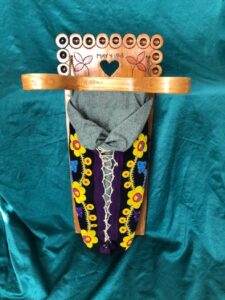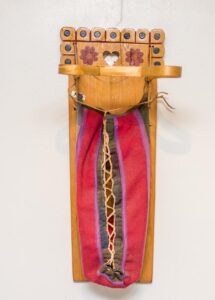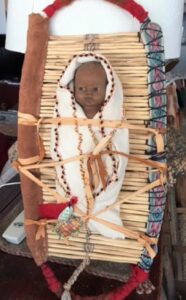Dakobinaawaswan: An interview with Shirley Stevens – the Cradleboard Carrier

By Beverly Sabourin and Peter Globensky
Backgrounder
Born in Toronto in 1951, Shirley Stevens’ first 15 years were spent growing up in the small rural village of Highland Creek. In her mid-teens, she began travelling to Northern Ontario and spent time in First Nations on Manitoulin Island, Lake Huron, Lake Nipigon, and Lake Superior. Moving first to Macdiarmid in Northwestern Ontario and then to Thunder Bay in 1968, she received her BA/BEd from Lakehead University and began teaching in Indigenous Studies at Lakehead’s Confederation College. Aside from continuous learning, her passions have been teaching, travelling and motorcycles. Most precious to her was the birth of her daughter Cree, now an accomplished artist, along with the Dakobinaawaswaan Cradleboard Project, and the 50 years of love, friendship and support of the Anishinabekwek Cradle Keepers. She lives on the shores of Gichi-gaming – the “great sea” of Lake Superior.
“These are living, breathing, spiritually infused extensions of living, breathing, spiritually infused peoples.” – Shirley Stevens, The Cradleboard Carrier
BAS/PAG: The Cradleboard Project has been a long and dedicated journey for you. You have gathered over 250 infant cradleboards representing Indigenous communities from across North America with many of these beautiful heirlooms going back many generations. What sparked your interest in this project?
SS: I received a tikanagan as a gift when I became pregnant. I was living in Biinjitiwaabek Zaaging [Anishinaabek] (formerly known as Rocky Bay First Nation) on Lake Nipigon, an incredibly spiritual place. I was gifted a family’s cradle by an elderly Anishinabaakwe who had raised 18 children in it. She also told me I would have a girl. It was such a powerful gift and was cared for lovingly. My daughter, Cree, spent the first seven months of her life in her cradle. She kept it with her and when it disappeared, her grief was inconsolable. I, on the other hand, pushed my grief deep inside, but it percolated over time. So, I think it’s better to say the Cradleboard Project found me. It didn’t start as a quest, or my quest, just a sense of “knowing” what I had to do; an important task for me, specifically. I knew I would somehow gather these cradleboards with the vague idea of ensuring there would be some undeniable recognition of the power of blood memory, community wellness, and cultural knowledge insurance for future generations. Although I didn’t realize it at the time, it became a way of healing from my loss. I also knew it was one of the most important things I would ever do. As the gathering grew and started to take on a life of its own, I turned to my closest friends of over 50 years, for support. They have assumed collective responsibility as Cradle Keepers.
BAS/PAG: Let us first go back to basics: What was the practical purpose of cradleboards? Although there are many differences between cradleboard designs depending on what communities they came from, they all share similar design characteristics. Why were they designed the way they were and what was their primary function?

SS: I believe Traditional Knowledge has always focussed on the utmost safety and protection of children for thousands of years. Indigenous Women gathered the best materials, from their respective environments to fashion cradles that reflected their commitment to providing the healthiest manner of child-rearing possible. Although they appear different based on where they come from, they all share the same purpose and they are all absolute marvels of complex engineering. To the contrary, colonial settler governments saw them as impediments to civilizing the “savages”. Churches claimed they were the work of the Devil and openly denounced them. Until about 10 years ago, colonial settler science reviled them for “disfiguring infants”.
BAS/PAG: Can you tell us about the early days of your collection? How did you begin to find and gather these cradles? Did you develop criteria for which ones you would choose? Did you start by tribal groups? And what means would you use to locate the cradles that would eventually become part of your collection?
SS: About five years ago, I was researching for my Masters of Education thesis about Indigenous Women’s traditional responsibility to continuity of community. I have the privilege of recounting the life stories of my oldest and dearest friends who bear witness to that commitment. Among the references I was checking was a listing for a tikanagan on a popular global shopping site. I was curious, so I followed it up. The style looked familiar but I couldn’t place it. I ended up buying one for Cree (not to replace her original) because we had both lived and have extended family in the northern reserve community where the seller said it had been made.
I started to think about how you didn’t see folks using cradleboards much anymore. They have been replaced by CSA approved cribs, carriages, car seats, etc. I wondered if that was true for just here or if the same was happing all over Turtle Island. So, I went looking. Disappointingly, but not unexpected, it was consistent everywhere. I decided to get four or five cradleboards representative of the tribal groups based on the directions of the Medicine Wheel. I wasn’t picky. They could be in any shape or size or condition. I was in awe of their ingenuity of construction and how they could be so different but all for the same purpose – the health, wellness and protection of children. That should have been it but I would find one that was a mix of a couple of tribal groups. I became conscientious about tribal relationships and connections translated through cradleboards. So many came with amazing stories and I met so many amazing people.
Finding them wasn’t difficult for me. They just kind of showed up or were put in front of me somehow and none of it has been by coincidence. I was instructed to keep an inventory by documenting each cradle and have done so.
BAS/PAG: We want to push you a little more on this: Why is the gathering of these cradleboards important to you. What do you plan to do with them?
SS: The act of bringing them together is a bit hard to explain. It was both intuitive and a feeling. It just felt right. No idea why at the time. I was flying blind and just had to trust that I might eventually find out. In the meantime, the important thing was to bring them together. I kept them all with me in my house. Children had lived the first part of their lives in most of them. I could feel them. The more cradles, the stronger the feeling. So, I didn’t really talk about them much partly because I couldn’t. I had no idea what was going on but I knew it was vitally important. The ‘Why?’ was elusive. How could I tell people when I couldn’t explain? What was I doing? People will think I’m crazy. I think I’m crazy. But, I kept at it.
There was no pivotal moment of understanding. No bright light. No ‘Ah-ha, I’ve got it!’
What I knew was it was not about me. It wasn’t even necessarily about the cradles. I was just bringing them together. And I knew it was about families, communities and Nations. It was also about history, cultural revitalization, and communal memories. It was about the women and the children. I was of the generation coming to the end of a cultural tradition using tikanagans for childcare. Cradleboard babies are few and far between now. Cradleboards are tangible proof of the reverence for children who are our future. It is within our living memory.
I’m overjoyed to say there are younger people in our Nations who recognize this and are re-vitalizing the art of cradleboard craft. They are teaching and encouraging others to use them and pass this tradition forward. Our spiritual Elder, Freda McDonald, emphasized how important it is to teach the children. She left us with that directive and shared her knowledge before she passed over.
Cradles need to be seen by as many people as possible, particularly the children. I’m hoping they go to schools, community centers, art galleries, museums, and anywhere they can remind and re-teach about our most precious resource – our children. They can play a critical part in a healing journey.
BAS/PAG: From this remarkable gathering of history and cultural tradition here and without asking you if you have a “favourite”, can you highlight one or two of them as having particularly impressed you because of their provenance or the stories connected to them or their age and history or the care in which they were crafted – or all of the above?

SS: Every cradle is unique, special, and one of a kind. The ones I’m highlighting are noteworthy for a few reasons:
There is a woven cedar strip cradle from the state of Washington on the Northwest Coast. A non-Indigenous gentleman became a “caretaker” of the cradle when the couple that had made it passed over. This couple was widely and well-known as Elders and healers. They were also the last people to know how to make cradles in that area. He wanted to pass it on with the hope that it will be seen and remembered.
Another basket cradle made from strips of oak came from the Coushatta people of Mississippi. It is also the last cradle to be made by the last person who knew how to make them. The fact there are less than 5,000 Coushatta left in Mississippi, Alabama, and Texas emphasizes its importance.
One of the Cradle Keepers felt that the Inuit needed representation. Cradle making materials are not readily available in the Arctic. Inuit Women have used the hood of their amaouti (parka) to carry their babies. Within a week, I was in touch with a Métis man who had an amaouti from an arctic community in Nunavut.
Pre-reservation period, the Northern Arapaho made hide cradles over a willow basket base. They decorated with symbolic quillwork. Their cosmology is incredibly and spiritually intricate. The only ones allowed to quill cradles were the Seven Old Women of the sewing guild. You had to train for many years before you were asked to be a member. War, disease, relocation, and starvation decimated their population to the point where no women were left who had been trained properly when they arrived on the reservations (late 1800s). The Four Old Men who guided the community declared no more cradles would ever be made again. As far as I know, they never have. So there are not many around. Most are in museum basements passed over for beaded cradles.
BAS/PAG: We know you do not like referring to the cradles as a collection, but you have to admit that you have amassed a gathering of cradles, if you will, of significant historical significance. What are you planning to do next? Will you continue acquiring these beautiful pieces? Do you plan to share your discoveries with the wider world?

SS: The English word “collection” does not adequately describe the intent of this group of cradles. Collection often describes a solitary undertaking for self, like a hobby. I have purposefully used the word gathering. It has a different intent. To me, it describes and implies it will be shared with others and is inclusive. This gathering is like a community.
Honestly, it’s not easy to just stop. I can say it has slowed down a lot. My feeling now is that there is enough breadth and depth to reasonably feel that it is representative of the beauty and diversity of a great many tribal Nations. The focus is now getting them out there to be seen by folks.
Thanks to local Indigenous artists and supporters, the Thunder Bay Art Gallery and the [Lake of the Woods Museum and the Douglas Family Art Centre in Kenora, Ont.,] have asked to exhibit some of them. They were scheduled until the COVID-19 lockdown in March 2020. I’m excited to announce that they will now be exhibited at the Thunder Bay Art Gallery starting [February 12, 2021,] followed by an exhibit at the Kenora Museum. Both of these locations lie at the heart of many Nations’ territories. I think it’s fitting that this is where they are seen first, in the territory where Cree’s cradle originated.
My hope is that these exhibitions will lead to other venues everywhere. I also hope they will find a home where they can be seen and used to teach. Some will need special care as they age. I was called by Johns Hopkins [University] about them and have their technical support if I need it. They run a program supporting the use of cradleboards for healthy childcare. That is a pretty big deal.
I also believe this is the heart of Truth and Reconciliation efforts. Cradles support the most precious and sacred bundles there are – the children.
BAS/PAG: It would seem that there would be financial assistance available out there for travelling and curating this important cultural cradle gathering beyond the geographic scope you have mentioned and thereby exposing it to a much broader audience. Have you plans to do so?
SS: Trying to find funding to support this venture was incredibly frustrating. In the end, the Ontario Arts Council had the only grant program for culture and recognition of artists from the past and present. We were able to complete an inventory and take photos of the cradles; but when the Conservative government came into power, they cut the program. So, we are back to square one with funding. Luckily, we have a supporter who has expertise in this area so we’ll see how it goes.

BAS/PAG: A final question for you. The cradleboard gathering you have so carefully and lovingly put together will outlive all of us. What plans do you have to ensure its survival and ongoing appreciation after we have all gone on to the Spirit World?
SS: It’s my fervent hope there will be a dedicated space for them in the future. We need to be reminded sometimes so it would be nice to have a display available to as many people as possible. I’m counting on the next generations to take that on. We need to remember that the first four lessons in life a child receives from a cradleboard: love, discipline, protection, and tradition. I think that just about sums up health and wellness for our children. By the way, in concluding, I want to say the reason I felt the cradle I found for my daughter Cree was familiar was because it is. You, Beverly, are a Cradle Keeper and it was your granny, Alice Sabourin, who made it. I only found out a year ago. I’m so lucky to have one of “Granny’s cradles” in our family.
Dakobinaawaswaan would not have happened without some very special people in my life, and to them a heartfelt miigwech; especially to my beloved and sacred bundle, Cree Stevens (Opwaaganisiniing), the cradleboard baby who lost her cradle and inspired Dakobinaawaswaan, to all my relations and to my spiritual guide, Freda McDonald, to whom I have dedicated this project.


